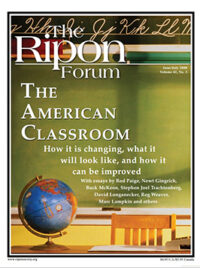Let me begin to answer the question proposed to me — are American high schools world class? — by muddying the waters with some facts and figures.

There are 17,662[i] school districts in the United States, 98,579 schools, 49,588,626 students, and 3,145,078 teachers or full-time equivalents. In the 100 largest school districts, which educate about a quarter of all high-school students and are mainly in California, Texas, Florida, and New York, spending per pupil ranges from $4,351 in Puerto Rico to $17,337 in Boston. In the same districts, the “averaged freshman graduation rate” is 70.2 percent. Citing more statistics would add even more confusion.[ii] Even without reporting to the last integer or decimal point, these are daunting numbers.
How does anyone conclude that American schools are world class or something else, presumably not as good? How do we sort out so many schools and districts — or rather their results? How do we evaluate secondary education in a continental nation that, from Maine to California, is more than twice the distance from Paris to Moscow?
We do not because today we cannot. We do not have a national policy on curriculum and standards of teaching and learning. Since the founding of the Republic, we have left such matters to the States to control locally. We do not have the tools to measure, and ultimately grade, the outcomes of education. The “science” of pedagogy is still in development. We know that the laws of physics and French grammar, for example, are the same in Rhode Island and Louisiana, but we have no confidence that they are being taught equally well or just equally, even in two Louisiana parishes or two Rhode Island counties.
We have favorable evidence about specific schools and school districts. The Bronx High School of Science and Stuyvesant High School in New York are celebrated as great successes in a vast American school non-system that often leaves a great deal to be desired. All the schools in Winnetka, outside Chicago, have for years had a reputation for offering some of the best public education anywhere in America. We can add examples, including Scarsdale in New York and Fairfax County in Virginia. Most of these communities are extremely well-to-do. There are specific schools in affluent neighborhoods in Washington, D.C., where, in general, the schools are unsatisfactory,[iii] that are doing better than expected because parents are contributing cash to pay for art and music programs, for example, and contributing time to student activities.
It is foolish to conclude that money alone buys quality and the exemplars I have offered are comparatively scarce. The $17,000 that Boston spends on each pupil has greatly improved public education over the last 20 years or so, but it’s a slow track. And no one example is typical of other large school districts. Affluent districts or individual schools seem to have better results. It’s not just a bigger budget. It’s also the concern that money represents, the environment it creates. It is not fair to compare a rich school or district to a poor one. Beyond wealth, sociology plays its part. The background students developed at home, which they have when they first open the school door, impacts on all later school achievement.
… we cannot possibly have a blended world-class education when some schools are starved and some enjoy more than enough.
But this obvious statement points to another problem in education and in assessing its success or failure. From one district to another — even in adjoining districts—the resources devoted to education can vary. Some states are taxing richer communities by capturing some of their real-estate taxes and transferring them to communities with smaller, and scantier, tax bases. (Naturally, this has provoked lawsuits.) I will offer a preliminary conclusion that we cannot possibly have a blended world-class education when some schools are starved and some enjoy more than enough.
Consider, after all, the burdens placed on the schools. Sex education, driver’s ed, and hot meals have become the province of schools, not parents, so budgets have to be found, often at the expense of instruction. In many districts, the students may be speaking one of 50 or 100 languages at home, and dealing with their problems cannot be done on the cheap, let alone for free. In the largest cities, many of the children are from poor households, often shattered ones, where the basic preparation for learning — such as reading to children or children seeing their parents read — is unknown. Dealing with these problems, and others as familiar, while delivering a first-rate education is beyond the means of most schools. Absent a national policy for financing public education and making it as high on our national agenda as defense, we can have no reasonable expectation of having world-class education anytime soon.
Let me offer a different kind of evidence. When I was still a university president, I wondered about offering a bachelor’s degree in three years instead of four as is the case in most of Western Europe.[iv] The economic arguments were strong, but the academic arguments were not dispositive because the high-school graduates arriving on most American campuses were simply not uniformly prepared to do sophomore work. We have known this for years. Many freshman courses are admittedly introductory. Too many others, like first-year writing programs, are covertly remedial. I cannot see how students who have a wobbly command of English grammar, often no second language, no knowledge of American history, or calculus, for example, can possibly be considered the offspring of a world-class educational enterprise.
We know that when American students take international math and science tests, they do not come out anywhere near the top. This may explain the demand of Ph.D. candidates for Indian engineers and Japanese biologists by American universities. And later businesses. This may also help to refine the slippery definition of “world class.” It is borrowed from sports, usually referring to athletes who compete in the Olympics and other worldwide competitions. In our context, it seems to refer to the ability of American high-school graduates to compete intellectually and professionally with their counterparts abroad. The evidence we have on their competitive status is mixed.
It would help, as I have suggested, to support education more generously and broadly, but money alone will not solve the problems that our vast and complex educational enterprise is not solving. But I have a modest proposal to get us started.
I would like to see tests provided that students might take at their discretion and that would measure their accomplishments in disciplines that permit comparison against international standards. Like the old New York State Regents’ exams, there could be separate examinations in different subjects: math, physics, chemistry, Arabic, English and so on. The reward for taking the test, not acing it, would be additional support for further education. Scholarships. This would help good students get even better. The reward, moreover, would only go to the students, not the schools or districts.
These terms are important. The tests required by No Child Left Behind leave teachers and schools frightened that they will be punished if their students do not do well. The results are negative all around: administrators and school boards feel bullied; teachers teach to the test rather than training young people how to read, write, calculate, and think; and in a globalized world, the tests do not measure our students against those abroad and, consequently, do not tell us if their education is world class or not.
By rewarding the students, we take away the threat of punishment from administrators and teachers. By making the test voluntary, we do not oblige the unwilling to participate—and avoid an inevitable political battle that would crush the idea under the weight of pointless debate and endless bickering.
The test would give us more than a measure of what a world-class education is. It would advance the idea in uniquely American terms, compelling no one, rewarding the willing, and—I am hopeful—begin to move our young people a little more rapidly in the direction of world class. Small victories taking us forward one step at a time—now that may be a big idea.
Stephen Joel Trachtenberg is Chairman of the higher education practice at Korn/Ferry International. He is also President Emeritus and University Professor of Public Service at The George Washington University.
[i] A more common number is 16,025, but the National Center for Education statistics include Puerto Rico, Bureau of Indian Education, and Department of Defense dependents schools in this total and the other totals in this paragraph. Data available at nces.ed.gov/pub2008/2008335.pdf
[ii] To avoid other confusion, I have limited my observations to public schools while understanding that private schools often perform better.
[iii] I hasten to note that Mayor Adrian Fenty and Schools Chancellor Michelle Rhee are heroically trying to dismantle and rehabilitate the schools in the District of Columbia
[iv] The Bologna Accords of 1999 included this provision, part of its goal of harmonizing the “architecture of European higher education.




